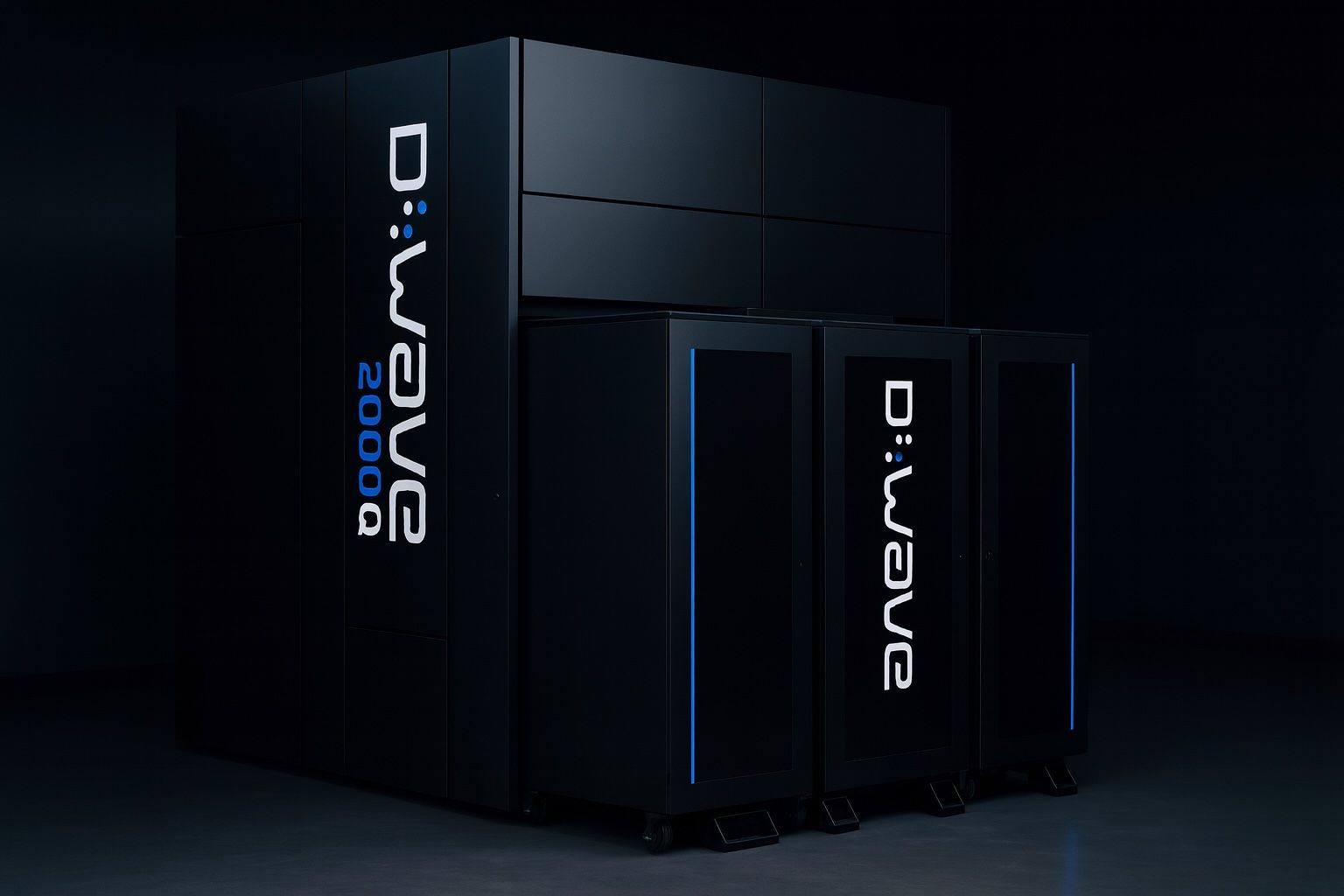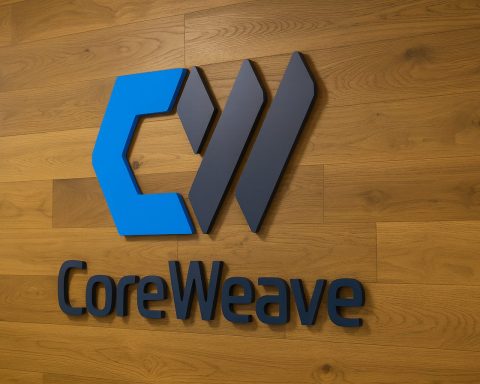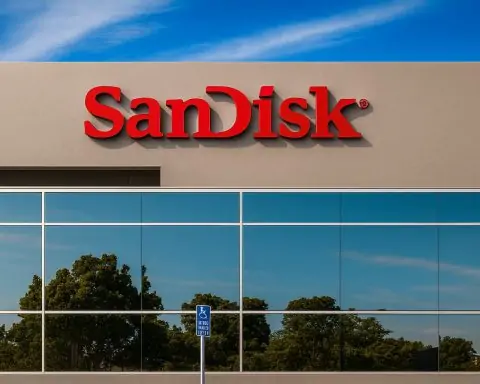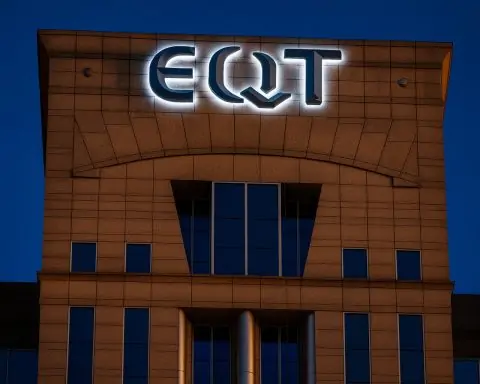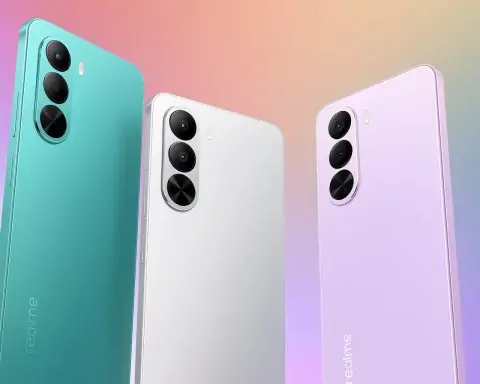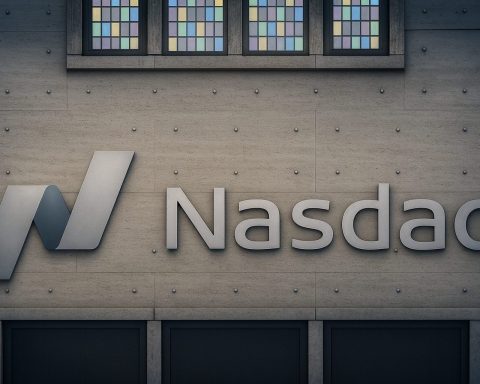- Spectacular 2025 Rally: D-Wave Quantum’s stock has skyrocketed over 200% year-to-date in 2025 (and more than 2,000% in the past 12 months) amid surging enthusiasm for quantum computing [1]. Shares recently hit all-time highs on heavy trading volume, reflecting intense momentum-driven gains in this nascent tech sector.
- Rich Valuation, Big Losses: The rally has far outpaced fundamentals. At a recent ~$30 share price, D-Wave’s market capitalization neared $9.5 billion – >400× its annual sales (~$22 million) [2]. The company remains unprofitable (Q2 2025 net loss was $167 million) [3], signaling significant cash burn despite revenue growth.
- Cash Boost and New Tech: D-Wave fortified its balance sheet with a $400 million funding raise in mid-2025, swelling its cash reserves to ~$819 million [4]. It launched the new Advantage2 quantum computer – a 5,000+ qubit annealing system touted to tackle complex optimization problems beyond classical reach [5]. This sixth-generation system and related tools (e.g. a quantum AI toolkit) underscore technical breakthroughs fueling investor optimism.
- Notable Partnerships & Projects: The company is expanding globally through partnerships. A NASA JPL collaboration is helping develop advanced cryogenic chip packaging as D-Wave pursues an ambitious 100,000-qubit roadmap [6]. In South Korea, D-Wave signed an MOU with Yonsei University to potentially install an Advantage2 system [7]. A pilot with North Wales Police demonstrated quantum’s real-world impact, cutting emergency response planning times by ~50% using D-Wave’s hybrid quantum solution [8] [9].
- Quantum Computing Hype vs. Reality: D-Wave operates in an early-stage quantum computing industry alongside peers like IonQ and Rigetti. All have seen stock prices explode (500%–1600% in the last year) as investors price in the promise of breakthrough technology [10]. However, big tech players (IBM, Google, Honeywell) are also in the race, and experts caution that current valuations reflect future potential more than present earnings. Analysts are split – B. Riley Securities recently hiked its QBTS price target to $33 citing rapid progress toward commercial viability [11], while others warn the stock’s surge is “purely on momentum” and could reverse without clear profit traction [12].
2025 Stock Performance: A Quantum-Fueled Rally
D-Wave Quantum’s share price has been on a tear in 2025, vastly outperforming the broader market. As of early Q4 2025, the stock had surged well over 200% year-to-date, and astonishingly over 2,000% from a year ago [13]. In other words, an investment in QBTS a year ago has grown over twenty-fold. This explosive rally reflects the market’s growing enthusiasm for anything “quantum” – D-Wave, along with its small-cap peers, became a high-flyer in 2025’s tech speculation boom [14] [15].
Market sentiment has been overwhelmingly bullish. A flurry of positive headlines – from new product launches to strategic partnerships – created a fear of missing out. For example, when D-Wave hosted its “Qubits 2025” user conference in Japan and showcased its latest tech, the stock jumped 19% in one day to fresh highs [16]. Investor optimism is being fueled by the sense that quantum computing is nearing an “inflection point” of real-world utility. Even Nvidia’s CEO (whose company’s stock soared on AI hype) has turned bullish on quantum, calling it at an inflection point for practical applications after years of skepticism [17]. Such endorsements from tech leaders have only added to the euphoria around quantum stocks this year.
However, the disconnect between D-Wave’s share price and its financial fundamentals is striking. The stock’s meteoric rise has pushed D-Wave’s market capitalization into the multibillion-dollar range – roughly $9.5 billion by October [18]. Yet D-Wave’s revenue over the last four quarters was only about $22 million, with no profits to show. In fact, the company continues to lose money; it booked a $167 million net loss in Q2 2025 alone [19] (partly due to accounting charges as its soaring share price triggered derivative liabilities). Even on an optimistic forward basis, the stock trades at triple-digit multiples of sales. One analysis pegged D-Wave’s valuation at 426× its trailing annual revenue – a level that assumes tremendous future growth [20]. This kind of “nosebleed” valuation [21] underscores that 2025’s stock performance has been driven more by speculation and momentum than by current business results.
Market observers note that D-Wave epitomizes the promise and peril of quantum computing as an investment theme [22]. On one hand, quantum tech is genuinely exciting and potentially transformative – a fact not lost on investors bidding up quantum stocks. On the other hand, D-Wave’s fundamentals (minimal revenue, ongoing losses, heavy cash burn) “scream caution” [23]. The stock’s rise has far outpaced what the company has tangibly achieved so far in financial terms. As Motley Fool’s analysts bluntly put it, D-Wave shares are “moving purely on momentum” at this stage [24], and momentum can flip quickly. In short, 2025’s performance reflects a speculative quantum gold rush mentality, and investors should be mindful that such rallies can be volatile and fragile without earnings to back them up.
Financials and Fundamentals Snapshot
To put the stock’s valuation in context, it helps to review D-Wave’s key financial metrics. Revenue is growing fast in percentage terms, but off a very small base. In Q2 2025, D-Wave reported sales of $3.1 million (up 42% year-over-year) [25]. For the first six months of 2025, revenue hit $18.1 million, a hefty 289% increase from the prior year period [26]. This jump suggests D-Wave is gaining some traction with customers, possibly through new cloud service usage or early Advantage2 system deals. The company has over 100 paying customers (cumulatively in the past year) ranging from enterprises to research institutions [27] – indicating growing interest in trying D-Wave’s quantum solutions.
Despite revenue growth, losses are mounting. D-Wave’s operating expenses continue to far exceed its top line. In Q2 2025 it incurred ~$28 million in operating costs, and after various charges the net loss widened to $167.3 million [28]. Part of this huge loss was due to one-time accounting effects (as surging share prices can trigger big non-cash expenses for SPAC-related warrants or stock-based compensation). Still, D-Wave is burning cash at an “alarming rate” in pursuit of quantum R&D and commercialization [29]. Prior to its capital raise, the company’s own management acknowledged negative operating cash flow and the need for more funding. Essentially, D-Wave is not yet financially self-sustaining, a common situation for early-stage deep tech companies.
The good news is that D-Wave shored up its balance sheet during the stock’s ascent. In mid-2025, the company took advantage of its higher share price to execute a massive at-the-market equity offering, raising $400 million in new capital [30]. As a result, D-Wave ended Q2 with $819 million in cash on hand, a record for the company [31] [32]. This war chest gives D-Wave breathing room to continue investing in development and even pursue strategic acquisitions or partnerships. Investors largely cheered this move – rather than diluting confidence, the financing was seen as enabling the company to “fortify its balance sheet” for growth [33]. Indeed, the capital raise has been one of the key bullish talking points, as it significantly reduces the near-term risk of running out of cash while the quantum technology matures.
Still, D-Wave’s valuation metrics remain extreme. Even after the stock’s recent pullback from highs, Wall Street estimates put D-Wave at hundreds of times its current revenue [34]. There are no earnings – D-Wave is likely years away from breakeven, let alone profitability. Traditional metrics like price-to-earnings are not applicable (negative earnings), so investors are valuing it on potential and progress rather than financial results. This makes the stock’s fate very sentiment-driven. Any disappointment or shift in market mood could trigger sharp swings. Thus, while D-Wave’s 2025 performance highlights the market’s appetite for quantum plays, it also comes with a reminder: investors are effectively betting on D-Wave’s future, not its present. Caution is warranted when so much of the valuation hinges on successful execution in the coming years.
Recent News & Strategic Developments
D-Wave’s big stock rally in 2025 has coincided with a string of notable news and strategic moves by the company. These developments paint a picture of a company racing to advance its technology, expand its user base, and stake out leadership in quantum computing’s early market. Here are the key recent developments that have fueled interest in D-Wave:
- Launch of Advantage2 System: In late Q2, D-Wave announced the general availability of its newest quantum computer, dubbed Advantage2 [35]. This is D-Wave’s sixth-generation quantum annealing machine, featuring over 5,000 qubits and significant improvements in connectivity, noise reduction, and coherence. The Advantage2 is designed to tackle complex optimization problems “beyond the reach of classical computers” – such as scheduling, logistics, and material science challenges – with greater speed and solution quality [36]. The system is touted as commercial-grade and energy-efficient, aimed at real-world use cases in optimization, simulation, and AI. The product launch has been a major validation of D-Wave’s technology roadmap, signaling that the company continues to push the frontier of annealing quantum computers. Investor enthusiasm for this “legitimate advancement” in D-Wave’s core tech has been high [37], as Advantage2 could attract more customers and use cases.
- Hybrid Quantum-AI Tools: Alongside its new hardware, D-Wave rolled out a suite of developer tools for quantum artificial intelligence. This included an open-source quantum AI toolkit that integrates with popular machine learning frameworks (like PyTorch), making it easier for developers to incorporate quantum processing into AI workflows [38]. D-Wave even demonstrated using its quantum processors to generate simple images as a proof-of-concept for quantum in AI [39]. By lowering the barrier for AI practitioners to experiment with quantum, D-Wave is positioning itself at the intersection of two cutting-edge fields. This helped bolster the narrative that D-Wave is not just about abstract science – it’s enabling practical exploration of quantum AI applications, a prospect that has excited tech-savvy investors.
- Major Funding Infusion: As mentioned, D-Wave secured $400 million in new funding via an equity offering (ATM program) completed in mid-2025 [40]. This was a cornerstone development for the company’s finances. Not only did it provide nearly half a billion dollars for growth, but it also signaled confidence that there was strong market appetite for D-Wave’s stock. The proceeds are earmarked for strategic opportunities and general corporate purposes (working capital, R&D, etc.) [41]. In essence, the raise gives D-Wave the firepower to accelerate development and even pursue acquisitions (for talent or technology) to maintain a lead. This funding news, combined with the Advantage2 launch, led one analyst to comment that “the momentum feels real” for D-Wave’s progress [42]. The stock’s climb in 2025 has been at least partly justified by the company’s strengthening resources and roadmap.
- Partnerships and Customer Wins: D-Wave has actively forged partnerships to expand its global reach. A headline collaboration was with NASA’s Jet Propulsion Laboratory (JPL). In August, D-Wave announced a new initiative on advanced cryogenic chip packaging, leveraging superconducting bump-bond tech developed at JPL [43] [44]. This R&D effort aims to connect multiple chips and scale both annealing and gate-model quantum processors – an important step toward D-Wave’s goal of eventually building systems with 100,000 qubits [45]. The JPL tie-up deepens D-Wave’s technological capabilities and credibility, showing it’s working with top-tier institutions to overcome engineering hurdles. Internationally, D-Wave is expanding in Asia. It announced a memorandum of understanding with Yonsei University and Incheon Metropolitan City in South Korea, which could lead to the first D-Wave Advantage2 system installed in that country [46]. Under the MOU, the parties will collaborate on quantum research, talent development, and potential local use cases (in biotech, materials, etc.), and work toward deploying an on-premise D-Wave system at Yonsei’s campus [47]. This kind of partnership not only opens a new market (South Korea) but also indicates that D-Wave’s hardware is gaining enough interest to possibly sell full systems (not just cloud access). Additionally, D-Wave has signed numerous new or expanded customer agreements in 2025. The list includes big names like E.ON (utility), GE Vernova (energy), Nikon, NTT Data, NTT Docomo, Sharp, and even the UK’s National Quantum Computing Centre [48]. These engagements, spanning industries from energy to telecom to government labs, demonstrate a growing commercial interest in D-Wave’s solutions. Each new customer adds a use case and potentially referenceable success story, feeding the positive news cycle.
- Real-World Pilot Success: Perhaps the most attention-grabbing news was a recent proof-of-concept project with the North Wales Police in the UK. In late September 2025, D-Wave and the police announced results of a pilot where D-Wave’s hybrid quantum computing was used to optimize police vehicle placement for emergency response. The outcome was striking: the quantum-powered solution reduced the planning computation time from 4 months to 4 minutes, and cut average incident response times by nearly 50% [49] [50]. In practical terms, D-Wave’s system helped determine optimal patrol car staging so officers could reach emergencies much faster. North Wales Police indicated this could be scaled more broadly to improve public safety and reduce costs [51]. For D-Wave, this is a milestone real-world validation. It’s one thing to theorize about quantum benefits; it’s another to show a tangible outcome like halving emergency response times. The news was widely covered and gave D-Wave a PR win. It reinforces D-Wave’s message that its quantum technology can deliver value today, not just in some distant future. Investors bid the stock up on this development, as it suggests D-Wave’s hybrid quantum approach can outperform classical methods in complex optimization tasks in the field [52] [53].
In summary, 2025 has seen D-Wave execute on several fronts: technical innovation (Advantage2), capital raise, strategic partnerships, and customer use cases. Each piece of news has helped strengthen the bullish narrative around the company. The combination of advancing technology, increased funding, and early adopter success stories has been powerful in driving market sentiment. That said, it’s important to note that many of these developments, while promising, are early-stage. The Advantage2 is newly launched (market adoption is just beginning), partnerships like the one in Korea are in initial phases, and the police pilot – while successful – was a demonstration, not a commercial contract. D-Wave still needs to convert these wins into sustainable revenue growth. Nonetheless, the steady drumbeat of positive developments in 2025 has kept investors excited and is a big reason why the stock keeps climbing despite the lack of profits.
Quantum Computing Industry Overview and D-Wave’s Role
D-Wave operates in the rapidly evolving quantum computing industry, which in 2025 finds itself at the crossroads of high promise and early hype. To understand D-Wave’s prospects, it’s helpful to view the broader industry landscape and where D-Wave fits within it.
Quantum computing uses the principles of quantum mechanics to perform computations far beyond the capability of classical computers. The technology is still nascent, but its potential – solving complex problems in cryptography, drug discovery, optimization, AI, and more – has been likened to a coming revolution in computing. This promise has led to a surge of investment and interest. In fact, quantum computing startups received over $1.25 billion in funding in just the first quarter of 2025 [54]. Major corporations, governments, and venture capitalists are all pouring money into this field, aiming to not miss out on what could be the next big computing paradigm.
Within the industry, there are two main technological approaches: gate-model (universal) quantum computers and quantum annealers. Gate-model quantum computers (pursued by companies like IBM, Google, IonQ, and Rigetti) use quantum bits (qubits) to run arbitrary algorithms, promising the ability to solve a wide range of problems if error correction can be achieved. Quantum annealers (pioneered by D-Wave) use qubits in a different way, focusing specifically on solving optimization problems by finding low-energy states of a system. Annealers are generally not universal – they’re specialized for certain problem types – but they can use a much higher number of qubits today (D-Wave’s systems have thousands of qubits, whereas gate-model machines currently have tens or hundreds of high-quality qubits). This dichotomy means D-Wave has a unique position: it was the world’s first commercial quantum computing vendor [55] [56], delivering quantum annealers to customers for years now, even as gate-model competitors are still in prototype or cloud-only phases.
D-Wave’s role in the industry has been that of an early mover and niche specialist. The company has staked out leadership in annealing-based quantum computing, which excels at things like optimization, scheduling, and sampling problems. Industries such as logistics, finance, and manufacturing have experimented with D-Wave’s technology for tasks like route optimization, portfolio optimization, and scheduling. D-Wave’s current Advantage/Advantage2 systems with ~5,000 qubits are well-suited to these specific use cases, and D-Wave has built a suite of software (like its Ocean SDK and hybrid solvers) to help clients program annealing machines. In sectors that need solutions to complex optimization problems today, D-Wave is often cited as the only practical quantum option since its machines are available now and can handle certain large-scale problems (albeit without guaranteed optimality or universal computing capability). The successful North Wales Police pilot is a case in point – it was an optimization problem tailor-made for D-Wave’s annealing approach, giving the company a chance to shine [57] [58].
However, D-Wave’s niche focus also comes with limitations. Quantum annealing cannot solve every class of problem, and it doesn’t run the kind of quantum algorithms (like Shor’s or Grover’s) that could disrupt fields like cryptography or database search. That’s the domain of gate-model quantum computers, where the competition is fierce and includes tech giants. IBM, for instance, has a 127-qubit superconducting quantum processor (with plans for a 1,000+ qubit device soon), and Alphabet’s Google famously demonstrated a form of “quantum supremacy” a few years ago. Honeywell’s spin-off Quantinuum (which recently got a $600 million investment led by Nvidia [59] [60]) is advancing trapped-ion quantum systems similar to IonQ’s. These players aim for fully error-corrected quantum computers in the next decade, which could tackle an even broader array of problems. If and when those general-purpose quantum machines become viable, D-Wave’s annealers could be overshadowed. D-Wave recognizes this and has quietly been developing its own gate-model quantum technology (the new cryogenic packaging initiative with JPL is partly to support superconducting gate-model chips alongside annealers [61]). But for now, D-Wave’s core product is still annealing, meaning its market is somewhat narrow relative to the grand vision of universal quantum computing.
In the present industry context, D-Wave is both a leader and an underdog. It’s a leader in that it has the most qubits and the most “real-world” deployments of quantum tech so far. Over 100 organizations have run problems on D-Wave’s systems [62], and the company emphasizes that millions of computational problems have been submitted to its machines to date [63]. This real-world track record is something many competitors cannot yet claim. D-Wave’s focus on practical, applied quantum computing (“quantum useful now”) resonates with some enterprise clients and sets it apart from peers that are primarily research-oriented.
Yet D-Wave is also an underdog compared to richly funded rivals working on gate-model breakthroughs. The quantum computing industry at large is still in R&D mode, and it’s unclear which approach will dominate or commercialize fastest. It could be that specialized annealing coexists with general quantum computers, each addressing different problems. Or, if universal quantum computers reach enough scale, they might handle optimization problems too (rendering annealers less necessary). D-Wave’s bet is that annealing offers a “right here, right now” value proposition for certain applications, allowing it to build a business and expertise while others chase longer-term goals. So far, this bet has yielded modest revenues but a lot of attention.
Another dynamic is the involvement of big mainstream tech firms like Nvidia, Microsoft, Amazon, and Honeywell in quantum. Nvidia, in particular, made waves by investing heavily in Quantinuum at a $10 billion valuation [64]. Nvidia’s CEO Jensen Huang’s newfound bullishness on quantum (after years of saying practical quantum was far off) has been interpreted as a sign that quantum computing’s time is nearing [65]. Nvidia is also integrating quantum into its ecosystem – for example, working with companies like Rigetti to use GPUs for quantum circuit simulations [66], and developing software platforms (like Nvidia’s CUDA-like tool for quantum, QODA). For D-Wave, the entry of giants like Nvidia could be a double-edged sword. On one hand, it validates the field and could bring in more investment and potential partnerships (e.g., D-Wave could leverage Nvidia hardware for hybrid computing). On the other hand, it means more competition and the risk that bigger players’ advancements (such as Nvidia-backed Quantinuum’s trapped-ion systems or IBM’s processors) steal the spotlight and customer mindshare.
In summary, the quantum computing industry in 2025 is characterized by immense excitement and rapid progress, but also uncertainty and fragmentation. D-Wave’s role is that of a pioneer of a specific approach (quantum annealing) that has proven useful in niche areas. The company has a head start in commercialization today, yet faces the challenge of maintaining relevance as the overall technology moves forward. D-Wave is trying to broaden its role – for instance, by pursuing gate-model development and highlighting hybrid quantum-classical computing for AI – but it remains to be seen if it can keep pace with competitors that may leapfrog in qubit count or computational power. For investors, D-Wave represents a pure-play way to bet on quantum computing’s future, with the understanding that its fate is intertwined with the overall trajectory of this high-risk, high-reward industry.
Comparing D-Wave to IonQ, Rigetti, and Nvidia
D-Wave Quantum is often mentioned in the same breath as IonQ (NYSE: IONQ) and Rigetti Computing (NASDAQ: RGTI) – two other publicly traded quantum computing companies. Each of these three has a different technical focus and business strategy, and their stocks have all been extremely volatile in 2025. We’ll also touch on Nvidia (NASDAQ: NVDA), not a quantum pure-play but a relevant comparison given its role in advanced computing and its recent foray into quantum investment. Here’s how D-Wave stacks up against these peers:
- IonQ (IONQ): Based in Maryland, IonQ is a leader in trapped-ion quantum computing. Unlike D-Wave’s annealers, IonQ builds gate-model quantum computers where each qubit is an individual ion trapped by electromagnetic fields. IonQ’s systems (like its latest Aria model with 25 high-fidelity qubits) have achieved some of the best quantum bit quality in the industry, which is crucial for running complex algorithms [67]. IonQ positions itself at the forefront of the “quantum race” in terms of qubit fidelity and a roadmap toward error-corrected, general-purpose quantum computers. It has strong partnerships with cloud providers – Microsoft Azure and Amazon Braket offer IonQ’s quantum processors via the cloud [68] – giving it broad access to users and developers. IonQ’s stock saw a massive run-up similar to D-Wave’s; in fact, IonQ was arguably the original quantum stock darling. Its shares nearly hit $55 in early 2025 amid quantum buzz, though they’ve since pulled back to around the low-$40s [69]. IonQ’s market cap, even after a dip, has been in the high-single-digit billions, making it slightly larger than D-Wave. Analysts often view IonQ as having the technological edge among the public quantum companies, given its hardware advances and ties with Big Tech. Nvidia’s recent investment in Quantinuum (a trapped-ion competitor) further validates IonQ’s approach in the eyes of investors [70]. That said, IonQ also faces no shortage of skepticism – it has virtually no revenue to date (a few million dollars annually, similar to D-Wave’s scale) and is burning cash on R&D. Its valuation is lofty, and any delays in achieving technical milestones could hit the stock. In 2025, IonQ’s stock performance has been choppy; after the early-year spike, it was roughly flat year-to-date by the fall [71], though still vastly up from 2024 levels. In comparison to D-Wave, IonQ targets the long-term, fully programmable quantum computing market. Investors bullish on quantum often own both, but might see IonQ as the play with higher long-term upside (and risk) while D-Wave offers nearer-term use cases.
- Rigetti (RGTI): California-based Rigetti Computing focuses on superconducting quantum processors, similar in underlying tech to IBM and Google’s approach. Rigetti aims to build gate-model quantum computers and has developed a series of chips (Aspen, Ankaa) with steadily increasing qubit counts and quality. Its recent Ankaa-2 system has 84 qubits with ~98% median gate fidelity [72] – an improvement but still behind the leaders in qubit count (IBM, for instance). Rigetti has distinguished itself with a focus on hybrid quantum-classical computing and has integrated its systems with classical cloud infrastructure. Notably, Rigetti has a partnership with Nvidia to use GPUs for simulating and error-correcting quantum circuits [73], aligning itself with Nvidia’s quantum-accelerated computing vision. The company also secured government contracts (like with the U.S. Department of Energy) and is working on quantum error correction with partners like Riverlane [74]. Rigetti’s journey as a public stock has been tumultuous. It went public via SPAC in 2022, struggled and saw its shares plunge into penny-stock territory by 2023 amid technical delays and management changes. However, in 2025 Rigetti staged an eye-popping rally – at one point the stock had risen over 1,000% from its lows, making it a “meme stock” of sorts for quantum enthusiasts. By September 2025, RGTI traded around $14–15 per share, which was actually down about 30% from its peak earlier in the year [75]. That still represented huge gains year-over-year. Rigetti’s smaller float and turnaround narrative (new CEO, refocused roadmap) contributed to its volatility. Analysts see Rigetti as a higher-risk name, given it lagged in technical milestones and still needs to prove it can compete with deeper-pocketed rivals. Yet, if it continues to improve its quantum chips and can ride the quantum hype, it has speculative appeal. Compared to D-Wave, Rigetti is targeting the same universal quantum computing space as IonQ, meaning it could address a broader range of problems in the future – but it also means Rigetti is in more direct competition with the likes of IBM/Google. D-Wave, with its annealing niche, isn’t directly head-to-head with Rigetti on technology, but from an investor perspective, both are small-cap quantum bets. Notably, B. Riley (the investment bank) has been bullish on all three – it recently raised price targets across the quantum sector, setting Rigetti’s target at $35 and D-Wave’s at $33, reflecting belief in further upside as quantum tech progresses [76].
- Nvidia (NVDA): Nvidia is a $1+ trillion semiconductor giant known for its GPUs, not a quantum computing company. So why include it here? Two reasons: context and convergence. First, context – Nvidia’s stock has shown how a company leading a breakthrough tech (in Nvidia’s case, AI accelerators) can deliver astronomical investor returns. Nvidia became one of 2023–2024’s best-performing stocks due to the AI boom, and many see parallels between AI and quantum as transformative technologies. This sets a broader tech context: investors chasing the “next Nvidia” have looked at quantum computing as a possible candidate for the next big thing. Indeed, headlines have even touted quantum stocks as potentially the “Next Nvidia” in terms of growth prospects. This has contributed to speculative flows into names like D-Wave, IonQ, and Rigetti – with the thinking that if quantum breakthroughs hit, today’s small players could become the Nvidia of tomorrow. Second, convergence – Nvidia has actively positioned itself in the quantum space through investments and products. As detailed, Nvidia’s venture arm invested $600 million in Quantinuum in 2025, doubling that company’s valuation to $10 billion [77]. Nvidia’s CEO also publicly acknowledged that quantum computing is closer to practical reality than he previously thought, saying it’s at an inflection point [78]. Moreover, Nvidia is developing tools to integrate quantum and classical computing (since any large-scale quantum system will need classical control and possibly error correction that GPUs can assist with). For example, Nvidia’s CUDA Quantum initiative (formerly QODA) aims to let developers use a unified programming model for quantum circuits and classical AI. Nvidia’s support thus provides a bridge that could accelerate quantum adoption. For D-Wave and peers, Nvidia’s backing of the sector is a positive sign – it brings credibility and resources. In fact, after Nvidia’s Quantinuum deal, quantum stock sentiment broadly got a boost [79] [80]. However, Nvidia’s involvement also highlights that the quantum industry is attracting serious attention from computing giants, which could mean tougher competition or eventual consolidation.
In comparing D-Wave, IonQ, and Rigetti: all three are unprofitable, early-stage companies with minimal revenues, and all three saw eye-popping stock gains over the past year (500% to well over 1000% in each case) [81]. This suggests a sector-wide speculative wave rather than company-specific fundamentals driving each stock. But their differentiation lies in technology and focus. D-Wave is the only one selling a proprietary quantum system that’s fully built and solving certain problems now (annealing-based, specialized). IonQ and Rigetti are chasing the holy grail of universal quantum computing (gate-based), which has bigger long-term TAM (total addressable market) but requires significant breakthroughs. From a risk perspective, D-Wave’s shorter-term usefulness might mean it can generate incremental revenue sooner (through cloud services or selling annealers for specific needs), whereas IonQ and Rigetti’s true payoff may be further out (but potentially larger if they achieve quantum advantage in broad applications). The stock market, however, has been valuing all of them on future potential, which is why their valuations all ballooned.
It’s also worth noting that outside these public companies, there are heavyweight private players (like IBM Quantum, Google Quantum AI, Quantinuum, PsiQuantum etc.) and dozens of startups worldwide. The competition to achieve technological supremacy in quantum computing is intense. No single company has “won” yet – there are multiple technology pathways and uncertainty on which will deliver scalable quantum computers first. This competitive backdrop is both a blessing and a curse for D-Wave. A blessing because excitement about any breakthrough in the field tends to lift all quantum stocks (a rising tide lifts all boats). A curse because D-Wave must continuously defend its approach and relevance as new breakthroughs (say, a leap in qubit count by a competitor) could make investors question D-Wave’s strategy.
In the eyes of some analysts, IonQ and Rigetti may be better positioned for long-term quantum computing leadership, while D-Wave’s more narrow focus carries higher execution risk [82]. For example, a recent 24/7 Wall St. investment analysis argued that Nvidia’s quantum investment underscores industry momentum for players like IonQ and Rigetti, whereas D-Wave’s niche annealing approach “limits its appeal” compared to those pursuing universal quantum computing [83]. The same analysis did acknowledge D-Wave’s recent revenue growth from quantum cloud services as a promising sign, but tempered enthusiasm noting the persistent losses and crowded competitive landscape [84]. In short, D-Wave might have more to prove to justify its valuation than its two rivals, in the view of some experts.
For investors, a broad takeaway is that quantum computing stocks as a group are high-risk, high-reward plays. D-Wave, IonQ, and Rigetti each tap into the quantum revolution narrative, but through different routes. Their stock prices can be extremely volatile, often moving in tandem on macro news (like interest rate changes affecting all speculative tech, or news of a breakthrough or investment in the sector). And while Nvidia is not a direct peer, its involvement acts as a sentiment barometer: bullish moves by Nvidia into quantum (or even just its bullish statements) have tended to lift quantum stocks broadly [85], whereas any dismissive stance could do the opposite (indeed, when Nvidia’s CEO was skeptical on quantum timelines back in early 2023, it contributed to dampening hype at the time).
In conclusion, compared to IonQ and Rigetti, D-Wave offers a unique value proposition – it’s selling practical quantum solutions now via its annealing systems, carving out a market in optimization tasks. IonQ and Rigetti are more about betting on future universal quantum capabilities. Depending on one’s outlook, D-Wave could be seen as either having a head start (with real use cases and customer traction) or as potentially stuck in a niche if universal quantum computing overtakes annealing in utility. And in the context of the wider tech space, all these quantum upstarts are far from the scale of a company like Nvidia, but they represent the tip of the spear of what could be a transformative technology over the next decade. The key for D-Wave will be to continue demonstrating that its approach can solve meaningful problems and to transition from proof-of-concepts to recurring commercial revenue before the larger quantum wave catches up.
Future Outlook: Forecasts and Analyst Views
Looking ahead, what can investors expect for D-Wave Quantum’s stock and business? The future forecast for QBTS is a mix of optimism about technological milestones and caution about valuation and execution. Here are several factors to consider, including Wall Street analyst expectations, company guidance, and technological roadmaps:
Analyst Ratings and Price Targets: D-Wave is covered by a handful of Wall Street analysts, and their views reflect the stock’s high-risk/high-upside profile. According to FactSet data, the consensus rating on QBTS is “Buy”, with around 10–12 analysts presently covering the stock. The average 12-month price target is about $23–24 per share [86]. This is actually below the current trading price, implying that some analysts feel the stock has gotten ahead of itself after the big run-up. The range of targets is wide: the lowest targets are around $20 (reflecting a more conservative outlook), while the high end is $33 [87] [88]. Notably, in late September B. Riley Securities raised its price target to $33 (from $22) and reiterated a Buy rating [89]. B. Riley’s quantum sector analyst, Craig Ellis, has been one of the more bullish voices. He argued that the quantum industry’s technical and commercial progress is accelerating faster than expected, justifying higher valuations [90]. Their research note highlighted evidence that what was once a “frontier” science is rapidly moving toward integrated, commercial capability [91] – a thesis that directly benefits companies like D-Wave if true. This led B. Riley to set $33 as a new Street-high target, essentially betting that D-Wave can outperform the more muted consensus.
The presence of a bullish outlier like B. Riley suggests some analysts see significant upside if D-Wave executes well and the quantum market expands. On the flip side, the fact that the average target (~$23) is below today’s price indicates many analysts are concerned about valuation and assume a pullback or plateau. Indeed, some are advising caution. For example, Motley Fool’s analysts (in a piece syndicated on Nasdaq) pointed out that with D-Wave’s stock at these levels, “momentum can turn on a dime” and investors should be careful about buying without evidence of profits [92]. We also saw Forbes and Zacks publish skeptical takes – one asking how D-Wave’s stock could eventually “fall to $1” if the hype implodes (a hyperbolic scenario, but meant to warn about downside risk), and another noting that competition from giants like IBM and Google could pressure D-Wave’s progress [93].
In terms of ratings, some sources list D-Wave with a “Strong Buy” consensus [94] [95], which likely means a majority of analysts call it a Buy, albeit often with the caveat that it’s suitable only for risk-tolerant investors. There have been no major downgrades publicly disclosed yet – partly because coverage is still relatively new (D-Wave went public in mid-2022, and more analysts initiated coverage only after the stock started gaining attention in 2023–2024). Going forward, watch for any changes in analyst tone after earnings reports or big news. A key factor will be whether D-Wave can deliver results that justify the optimism (e.g. booking more revenue from Advantage2, or securing paid deals from those MOUs and pilots). Any signs of slower adoption could lead some analysts to temper their targets.
Company Guidance and Roadmap: D-Wave’s management has laid out an ambitious vision. While they generally do not provide quarterly or annual revenue guidance in the traditional sense (expected, given the early stage), they speak of a long-term “product roadmap” aiming for 100,000 qubits and enhanced capabilities. This 100K-qubit goal, frequently mentioned in D-Wave’s materials [96], is a moonshot target without a specific date publicly attached – it’s more of a north star for their R&D. Reaching that scale would presumably involve connecting many chips (hence the need for the new multichip packaging techniques). Importantly, D-Wave is working on gate-model qubit development in parallel to its annealing line. CEO Alan Baratz has indicated that D-Wave is uniquely pursuing both annealing and gate-model architectures [97], which, if successful, could position the company to offer customers the best of both worlds. However, concrete timelines for a D-Wave gate-model quantum computer haven’t been announced to investors yet. It’s something to watch in future company updates – if D-Wave can unveil a prototype gate-model processor or articulate a clearer timeline for a universal quantum machine, it might significantly impact the stock (likely positively, as it would expand D-Wave’s addressable market).
In terms of nearer-term business goals, D-Wave likely aims to grow its Quantum Computing as a Service (QCaaS) revenue via its Leap cloud platform, attract more enterprise customers, and hopefully convert some of its partnerships into direct system sales or large subscription contracts. The recent customer list expansion [98] bodes well – if even a few of those big names (like GE, NTT, or Nikon) progress from pilot projects to real deployments, D-Wave’s revenue could inflect upwards. Investors will be looking for any hints of that in upcoming earnings calls. Additionally, with ~$800M in cash, management has noted they could pursue strategic acquisitions. Perhaps they might acquire a smaller quantum software firm or a complementary tech to accelerate their gate-model efforts. Such moves could be on the horizon given the capital available.
Another aspect of guidance is research milestones. D-Wave might update the public on qubit count improvements or performance metrics of its Advantage2 and follow-ons. For example, if they plan a next iteration with even more connectivity or a larger lattice of qubits, that could be news. Right now, Advantage2 (in current form) was a big leap over the prior generation in design, but still around the same order of qubits (~5K). D-Wave’s older roadmap had talked about a 7000+ qubit device as a next step. Any announcement that D-Wave is, say, doubling its qubit count or achieving a new record annealing performance would reinforce its lead in that niche.
Technological Developments to Watch: Beyond D-Wave’s own milestones, the broader quantum field developments will influence its outlook. If a competitor like IonQ or IBM announces a major breakthrough (e.g. significantly higher quantum volume, or a small error-corrected quantum computer), it could either raise all quantum stocks (through increased excitement) or cause rotation if investors deem one approach superior. For instance, if IonQ were to demonstrate a big jump in algorithmic qubits, some might favor IonQ over D-Wave. Conversely, should annealing find a “killer app” or a breakthrough (like solving a particular industry problem demonstrably better than any classical method), that would greatly strengthen D-Wave’s hand. So far, D-Wave’s narrative has been about incremental improvements and use-case demonstrations (like the police project) rather than a singular breakthrough. Investors will continue to scan for any sign of quantum advantage – the point where a quantum computer outperforms classical computers for a useful task. D-Wave has claimed “quantum practical advantage” in certain cases (problems where its hybrid solvers beat classical alternatives in speed/quality), but skeptics might want to see more rigorous proof and at scale.
Market Sentiment and Macro Factors: The future of QBTS is also tied to market conditions. As a pre-profit speculative tech stock, D-Wave is sensitive to interest rates and risk appetite. The 2025 rally happened in an environment where tech stocks broadly were buoyant and investors were looking for growth stories. If the macro environment changes – say, higher interest rates or a shift out of high-valuation stocks – D-Wave could see increased volatility or a correction. On the other hand, continued enthusiasm for disruptive tech (AI, quantum, space, etc.) could keep D-Wave in favor. Notably, quantum computing has become one of the “exciting new narratives” on Wall Street [99], sometimes even lumped alongside AI as the next frontier. Any major world event highlighting the need for advanced computing (for example, cybersecurity threats where quantum encryption is discussed, or breakthroughs in materials requiring quantum simulation) can suddenly shine a spotlight on this sector.
Given all these factors, what do experts say about D-Wave’s specific outlook? We have a few instructive quotes:
- Bullish case: B. Riley’s analysts essentially argue that real commercial traction for quantum is getting closer, and D-Wave will benefit as one of the few investable pure-plays. They see government and enterprise efforts moving from pure research to practical development, which could translate into more contracts for companies like D-Wave [100]. If D-Wave can convert even a slice of the interest from national labs or large companies into deals, its revenue could multiply quickly from the current baseline. The bullish camp often points out that D-Wave’s current ~$20M annual revenue could just be the tip of the iceberg if quantum computing adoption accelerates – much like early cloud computing companies had small sales before the cloud went mainstream. Thus, a forecast from this perspective is that D-Wave’s sales might ramp substantially in coming years, which would make the valuation appear less extreme in hindsight (though it’s a big “if”). Some optimists even speculate D-Wave could become a takeover target for a larger tech company wanting quantum IP, although there’s no concrete evidence of that right now.
- Bearish case: More cautious analysts and writers stress that D-Wave is priced for perfection and then some. As Motley Fool’s Rich Smith noted, at over 400× sales with no profit, the stock’s momentum-fueled gains could reverse sharply on any stumble [101] [102]. The bearish view is that D-Wave will likely need years to grow into its valuation, and during those years it could face dilutive financing (though the recent raise lessens that risk near-term) or simply a realization by investors that adoption is slower than hoped. There’s also the risk of dilution from things like employee stock compensation – common in tech startups – which can expand the share count. From a technology standpoint, skeptics question whether annealing quantum computing will ever break out of a niche. If not, D-Wave might remain a small revenue generator, serving specialized optimization use cases, while the big economic value in quantum goes to whoever cracks general-purpose quantum computers. The Forbes piece alluding to how D-Wave’s stock could “fall to $1” likely was using a provocative scenario: if the quantum bubble bursts or if a recession makes investors flee speculative stocks, a company like D-Wave could theoretically crash back down. While that’s an extreme scenario, it underscores the volatility and downside possible in such a stock if sentiment sours.
Our Take – What to Watch: Going forward, investors should watch D-Wave’s quarterly earnings reports for concrete progress indicators: sequential revenue growth, new customer counts, backlog or bookings (D-Wave did disclose a modest $1.3M in Q2 bookings, up 92% YoY [103] [104]), and cash burn rates. With the big cash reserve now, solvency isn’t an immediate worry, but prudent cash management will be important (spending $20-30M per quarter as they have will eat into that war chest over a few years). Also watch for any guidance or commentary from management on revenue pipelines – if they hint at larger deals or increasing demand, that would be bullish. Technologically, keep an eye on D-Wave’s next steps: Will they announce a significant upgrade (perhaps an Advantage2+ with more qubits or better performance)? Will there be news on their gate-model efforts? Or new partnerships (for instance, could they partner with a cloud provider or a systems integrator to reach more customers)? Each of these could influence the forecast for the company’s growth.
On the industry side, monitor events like the Quantum World Congress or academic breakthroughs – these often generate news that moves quantum stocks. In fact, B. Riley’s recent target raise was after attending the Quantum World Congress, where they evidently came away more impressed at the field’s progress [105]. So industry conferences and announcements can be catalyst moments.
In summary, the future outlook for D-Wave Quantum is that of a high-upside but high-uncertainty trajectory. If the company continues hitting technical milestones, securing new business, and if the quantum computing field advances as bulls expect, D-Wave could grow into a much larger enterprise over the next 5–10 years (and potentially its stock could follow). Analyst scenarios like a $30+ stock price assume strong execution and market growth. However, any number of pitfalls – slower adoption, competition, macro pullback – could lead to a significant reversal. That duality is why some experts call quantum computing stocks “Wall Street’s favorite speculation” [106] right now: they encapsulate a grand vision of the future, but require patience and risk tolerance. Investors considering D-Wave should be prepared for a bumpy ride, stay tuned to both company developments and quantum industry news, and evaluate whether the company’s progress each quarter aligns with the lofty expectations priced into the stock.
Conclusion: High Potential, High Risk
D-Wave Quantum Inc. has delivered a remarkable story in 2025 – a surging stock price fueled by quantum computing’s promise, backed by genuine advancements like a new 5,000-qubit system and real-world pilot successes. The company has strengthened its finances and is aggressively pushing the envelope in an exciting frontier of technology. In many ways, D-Wave embodies the “quantum leap” that investors hope will transform computing and justify the current hype.
However, this investment story comes with significant caution flags. The stock’s fundamentals are out of sync with its valuation, resting on future potential rather than present performance. Competition is intensifying, and the timeline for quantum computing to fully mature remains uncertain. As one analyst warned, momentum-driven rallies can reverse quickly [107], and at 400+ times sales, D-Wave will eventually need to “show me the money” in terms of revenue and profits to sustain its market value.
For investors, D-Wave (QBTS) offers exposure to the quantum computing revolution – a chance to get in early on what could be transformative tech, much like investing in early internet or AI companies. The upside could be enormous if D-Wave secures a profitable niche or if quantum computing achieves mainstream adoption faster than expected. Yet, one must also be prepared for extreme volatility and the possibility that things don’t pan out as hoped (at least not on the optimistic schedule that current valuations imply).
The bottom line is that D-Wave Quantum is a bold, speculative play in a cutting-edge industry. It has the cachet of being a first mover with tangible quantum solutions and a growing ecosystem of partners and clients. It also has the burden of justifying a multi-billion dollar market cap despite tiny revenues and hefty losses. In the coming years, we will see whether D-Wave can bridge that gap by converting quantum promise into profitable reality. Until then, anyone eyeing this stock should keep both the immense potential and the considerable risks clearly in mind – truly, a quantum leap in more ways than one.
Sources:
- Investopedia – “Watch These D-Wave Quantum Price Levels as Stock Soars to Record High”, Sep 18, 2025 [108]. (Stock up ~170% YTD and 2,000% YoY; investor sentiment boosted by new system launch and tech optimism)
- Motley Fool via Sharewise – “Is D-Wave Quantum Stock Still a Buy?”, Sep 26, 2025 [109] [110]. (Quantum stocks as speculative favorites; D-Wave up 213% YTD on breakthroughs and $400M raise; fundamentals weak with heavy cash burn)
- Motley Fool via Nasdaq – “Why D-Wave Quantum Stock Keeps Going Up”, Oct 2, 2025 [111] [112]. (Market cap ~$9.5B vs $22.3M sales = 426× sales; stock running on momentum, caution against chasing hype)
- D-Wave Quantum Press Release – “D-Wave Reports Second Quarter 2025 Results”, Aug 2025 [113] [114]. (Q2 revenue $3.1M, +42%; completed $400M ATM funding, cash balance $819M; launched Advantage2 system; initiative with NASA JPL toward 100,000-qubit development)
- D-Wave News – “North Wales Police and D-Wave Announce Hybrid-Quantum Application…”, Sep 30, 2025 [115] [116]. (Hybrid quantum optimization project cut solution time from 4 months to 4 minutes and halved police response times ~50% in trial)
- 24/7 Wall St. – “Nvidia’s $600 Million Quantum Computing Bet: Time to Buy Rigetti, IonQ, or D-Wave?”, Sep 5, 2025 [117] [118]. (Overview of IonQ, Rigetti, D-Wave; D-Wave’s annealing focus with 5,000+ qubits serves optimization niche, but universal quantum players seen as having broader appeal; revenue growth promising but losses and competition temper enthusiasm)
- TipRanks (The Fly) – “B. Riley raises D-Wave Quantum price target to $33, keeps Buy”, Sep 22, 2025 [119]. (Analyst note: Quantum sector progress outpacing prior views; former “frontier tech” moving toward commerciality, supporting higher valuation; B. Riley sees industry momentum post-Quantum World Congress)
- MarketScreener/FactSet – Analyst Consensus on D-Wave Quantum [120]. (Approx. 10 analysts; average price target ~$23.30, low $20, high $33; consensus rating Buy as of Sep 2025)
- Zacks Investment Research – “Top Quantum Stocks Eyeing a Breakout (QBTS, IONQ, RGTI)”, Sep 3, 2025 [121]. (Quantum computing one of the most exciting new market narratives; D-Wave, IonQ, Rigetti shares surged ~500% to 1600% in last 12 months as investors price in future innovation)
- Nasdaq.com – “Why Did D-Wave Quantum Stock Skyrocket 14% Today?”, Sep 2025 [122] [123]. (Stock spiked on no new news that day, likely riding momentum; earlier in week, D-Wave announced the North Wales Police pilot success, highlighting real-world quantum application and boosting sentiment)
References
1. www.investopedia.com, 2. www.nasdaq.com, 3. finance.yahoo.com, 4. www.dwavequantum.com, 5. www.dwavequantum.com, 6. www.dwavequantum.com, 7. www.dwavequantum.com, 8. ir.dwavesys.com, 9. ir.dwavesys.com, 10. tiblio.com, 11. www.tipranks.com, 12. www.nasdaq.com, 13. www.investopedia.com, 14. www.sharewise.com, 15. tiblio.com, 16. www.investopedia.com, 17. 247wallst.com, 18. www.nasdaq.com, 19. finance.yahoo.com, 20. www.nasdaq.com, 21. www.sharewise.com, 22. www.sharewise.com, 23. www.sharewise.com, 24. www.nasdaq.com, 25. www.dwavequantum.com, 26. www.dwavequantum.com, 27. www.dwavequantum.com, 28. finance.yahoo.com, 29. www.sharewise.com, 30. www.dwavequantum.com, 31. www.dwavequantum.com, 32. www.dwavequantum.com, 33. www.sharewise.com, 34. www.nasdaq.com, 35. www.dwavequantum.com, 36. www.dwavequantum.com, 37. www.sharewise.com, 38. www.dwavequantum.com, 39. www.dwavequantum.com, 40. www.dwavequantum.com, 41. www.dwavequantum.com, 42. www.sharewise.com, 43. finance.yahoo.com, 44. www.dwavequantum.com, 45. www.dwavequantum.com, 46. www.dwavequantum.com, 47. www.dwavequantum.com, 48. www.dwavequantum.com, 49. ir.dwavesys.com, 50. ir.dwavesys.com, 51. ir.dwavesys.com, 52. www.nasdaq.com, 53. www.nasdaq.com, 54. 247wallst.com, 55. ir.dwavesys.com, 56. ir.dwavesys.com, 57. ir.dwavesys.com, 58. ir.dwavesys.com, 59. 247wallst.com, 60. 247wallst.com, 61. www.dwavequantum.com, 62. ir.dwavesys.com, 63. ir.dwavesys.com, 64. 247wallst.com, 65. 247wallst.com, 66. 247wallst.com, 67. 247wallst.com, 68. 247wallst.com, 69. 247wallst.com, 70. 247wallst.com, 71. 247wallst.com, 72. 247wallst.com, 73. 247wallst.com, 74. 247wallst.com, 75. 247wallst.com, 76. longbridge.com, 77. 247wallst.com, 78. 247wallst.com, 79. 247wallst.com, 80. 247wallst.com, 81. tiblio.com, 82. 247wallst.com, 83. 247wallst.com, 84. 247wallst.com, 85. 247wallst.com, 86. www.marketscreener.com, 87. www.sahmcapital.com, 88. www.marketscreener.com, 89. www.tipranks.com, 90. www.tipranks.com, 91. www.tipranks.com, 92. www.nasdaq.com, 93. tiblio.com, 94. public.com, 95. stockanalysis.com, 96. www.dwavequantum.com, 97. ir.dwavesys.com, 98. www.dwavequantum.com, 99. tiblio.com, 100. www.tipranks.com, 101. www.nasdaq.com, 102. www.nasdaq.com, 103. www.dwavequantum.com, 104. www.dwavequantum.com, 105. www.tipranks.com, 106. www.sharewise.com, 107. www.nasdaq.com, 108. www.investopedia.com, 109. www.sharewise.com, 110. www.sharewise.com, 111. www.nasdaq.com, 112. www.nasdaq.com, 113. www.dwavequantum.com, 114. www.dwavequantum.com, 115. ir.dwavesys.com, 116. ir.dwavesys.com, 117. 247wallst.com, 118. 247wallst.com, 119. www.tipranks.com, 120. www.marketscreener.com, 121. tiblio.com, 122. www.nasdaq.com, 123. www.nasdaq.com
